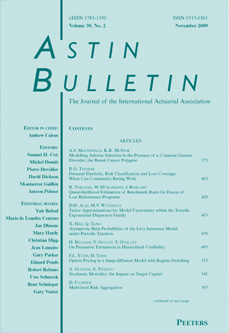 previous article in this issue previous article in this issue | next article in this issue  |

|
Document Details : Title: Bayesian Stochastic Mortality Modelling for Two Populations Author(s): CAIRNS, Andrew J.G. , BLAKE, David , Dowd, Kevin , COUGHLAN, Guy D. , KHALAF-ALLAH, Marwa Journal: ASTIN Bulletin Volume: 41 Issue: 1 Date: 2011 Pages: 29-59 DOI: 10.2143/AST.41.1.2084385 Abstract : This paper introduces a new framework for modelling the joint development over time of mortality rates in a pair of related populations with the primary aim of producing consistent mortality forecasts for the two populations. The primary aim is achieved by combining a number of recent and novel developments in stochastic mortality modelling, but these, additionally, provide us with a number of side benefits and insights for stochastic mortality modelling. By way of example, we propose an Age-Period-Cohort model which incorporates a mean-reverting stochastic spread that allows for different trends in mortality improvement rates in the short-run, but parallel improvements in the long run. Second, we fit the model using a Bayesian framework that allows us to combine estimation of the unobservable state variables and the parameters of the stochastic processes driving them into a single procedure. Key benefits of this include dampening down of the impact of Poisson variation in death counts, full allowance for paramater uncertainty, and the flexibility to deal with missing data. The framework is designed for large populations coupled with a small sub-population and is applied to the England & Wales national and Continuous Mortality Investigation assured lives males populations. We compare and contrast results based on the two-population approach with single-population results. |
